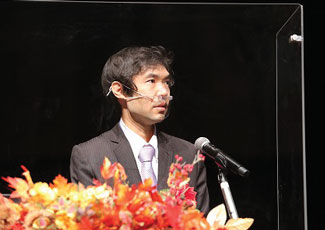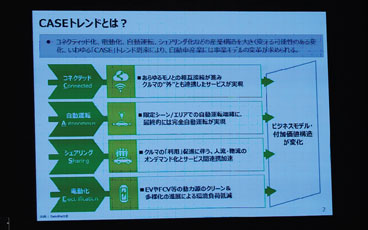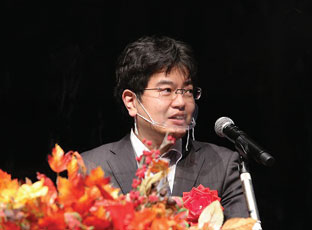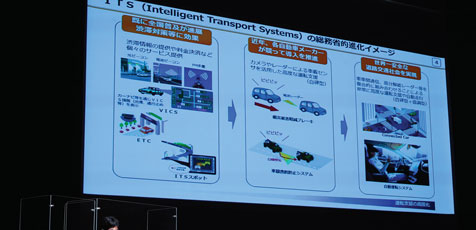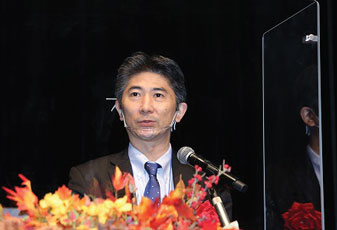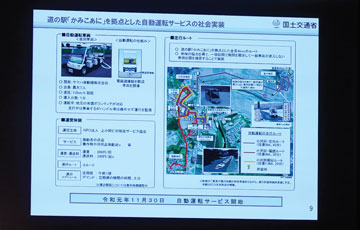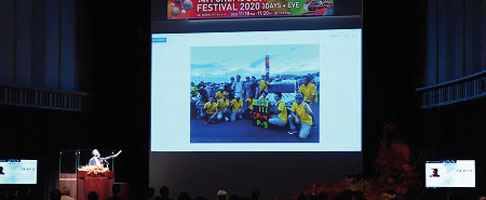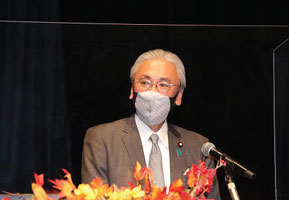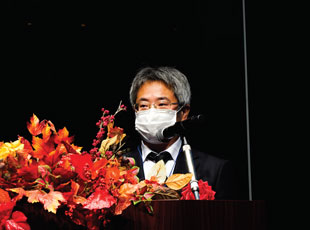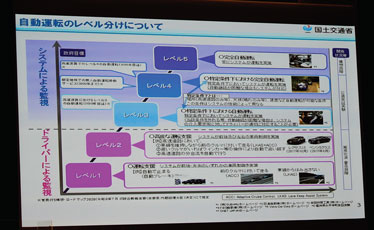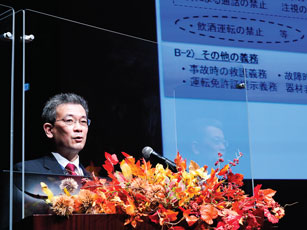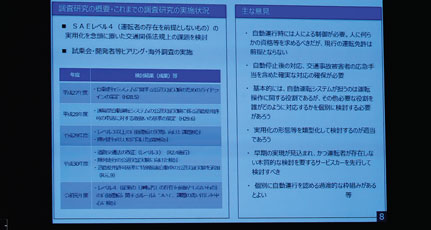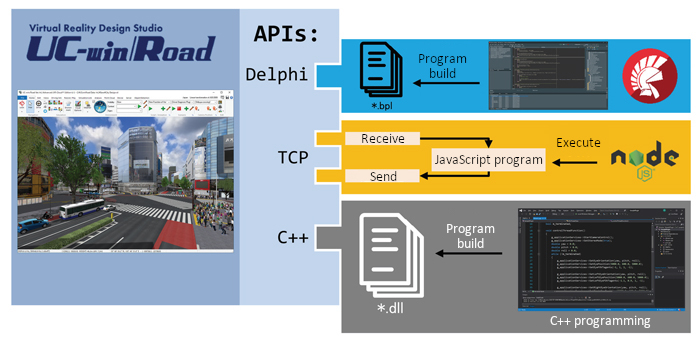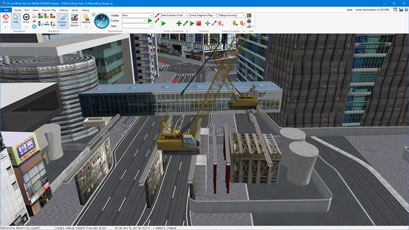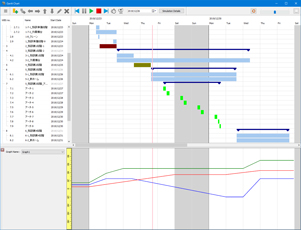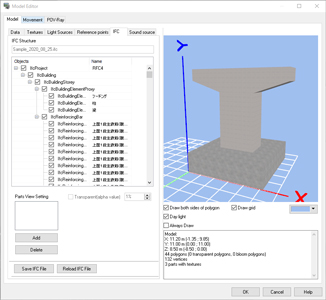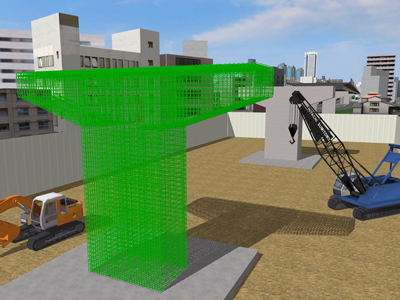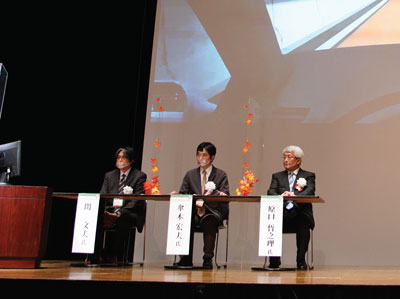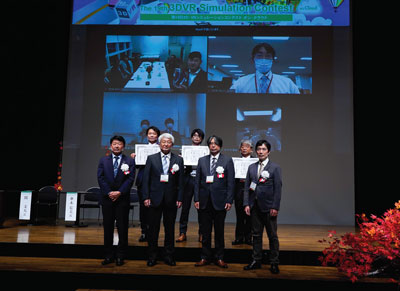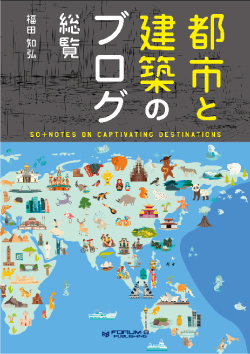| Advancing VR-based Solutions in Consideration of DX as well as Telework
Design Festival Day1 opened up with "the 5th Autonomous Driving Conference" continuing from the morning to the first half of the afternoon session. Following guest-of-honor greetings, 5 persons in charge at the related 4 ministries and agencies gave lectures on the latest trends on policies and technologies related with autonomous driving and so on, which shows steady progress year by year. Next, in "Virtual Reality Design Studio UC-win/Road Presentation", FORUM8's VR solutions for supporting research and development related to autonomous driving were presented. In the second half of the afternoon session, prize announcement and award ceremony for "the 19th 3DVR Simulation Contest on Cloud" were held. In advance, 10 works had been nominated out of the competition entries. Prizes were determined through popular vote (November 5-15) using VR-Cloud® and the judging committee (November 17). After these sessions were over, lectures were given by the authors and editorial supervisors of 3 brand-new books from FORUM8 Publishing: "Structural analysis based on numerical simulation, Augmented and revised edition", "City and Architecture Blog: Overview 50+Notes on Captivating Destinations", and "Expression Technology Certification Database Official Guidebook” The morning session of Day2 was opened up by the presentation for "the 21th UC-win/Road Conference". It was followed in the latter part of the morning by the final public judgment for "the 8th CPWC" (with 8 works nominated previously from among the entry works) and "the 10th VDWC" (with 9 works). In the first half of the afternoon session, after a speech of Chairman for the State of the Art Technologies in Expression Association, the special lecture for "the 6th State-of-the-art technical cooperation, latest technology art session" was given. Then, prize announcement and award ceremony of "the 4th Hagura Award" by the Association were held (with 13 works nominated from the entries). Subsequently, "the 13th International VR Symposium" was held. After the missions and activities of "World16" were introduced, "World16"members (12 members present) from all parts of the world connected online made presentations about their respective projects. Finally, they mentioned their idea about our product development related with those projects. In the second half of the afternoon session, prize announcement and award ceremony of "the 8th CPWC", "the 10th VDWC", and "the 6th Junior Software seminar" were held with Mr. Patrick Harlan as the presenter. In Day 3 (the final day of Design Festival), special lectures for "The 14th Design Conference IM&VR / i-Construction Session" were given and presentations of FORUM8's solutions related with DX were made from the morning to the first half of the afternoon session. In the second half of the afternoon session, following our presentation of solutions related with BIM / CIM and FEM analysis, the prize announcement and award ceremony for "the 7th NaRDA" (for 8 works nominated previously from the entry works, judges made final judgement on Nov. 17) were held. The number of visitors at the venue and online exceeds 2,000 in accumulating total in this Design Festival this time (including the Eve). To Realize World of Level 3 of Autonomous Driving, Infrastructure Development for Technologies and Institution Conceived in Consideration of the Next Phase Day1 of the Design Festival (Nov. 18, 2020) opened up with opening speech by CEO and President of FORUM8, Yuji Ito. Then "the 5th Autonomous Driving Conference" started with the special lecture "METI's involvement to realize autonomous driving" by Mr. Kenji Ueki, Director, Autonomous Driving and ITS Promotion Office, Automobile Division, Manufacturing Industries Bureau, Ministry of Economy, Trade and Industry (METI). First of all, he outlined the concept of the trend that the automobile industry is facing called "CASE" ("Connected" cars, "Autonomous / Automated" driving, "Sharing and service", and "Electric"), coordination with other ministries and agencies to promote this, the past flow about CASE from research and development to its full-scale spread and its future prospect, and the direction of supporting construction of mobility society including MaaS (Mobility as a Service). Then he summarized the definitions of significance of autonomous driving (1) safe and smooth road traffic, 2) society that allows comfortable movement, 3) improvement in the industrial competitiveness and efficiency of the related industry), the autonomous driving system, levels of autonomous driving (SAE Level 0 to 5). He also mentioned the following: social implementation of the level 4 preceding with commercial vehicles, trends of autonomous driving in the world (e.g. provision of institution about levels 3 and 4), and efforts required for realizing autonomous driving (technological development, provision of infrastructure and institution, and improvement in social acceptability). Moreover, his speech was developed from a viewpoint of promoting social implementation to METI's activities about autonomous driving, and circumstances of promoting demonstration experiments that go along the roadmap towards realization and spread of autonomous driving service. He also mentioned the measures to cope with 10 highlighted areas (maps, communications infrastructure, recognition technology, judgment technology, human engineering, safety, cyber security, software human resources, social acceptability, and safety evaluation).
Next, Mr. Yamato Igarashi, Mobile Communication Section Chief, Radio Department, General Communication Infrastructure Bureau, Ministry of Internal Affairs and Communications (MIC) gave a special lecture entitled "Trends toward the realization of autonomous driving and efforts by the Ministry of Internal Affairs and Communications". He explained the image of progress of ITS (Intelligent Transport Systems) from the viewpoint of MIC, usage of radio wave in it and MIC's involvement, and the outline of MIC's policies concerning the driving support system. Then he summarized, in particular, the image of realization of Connected Car and requirements of communication for realizing Connected Car society. He mentioned V2X, which means communication between a vehicle and various things. Further, he talked about technological examination required for the next-generationV2X system, verification of the influence that the system has on the existing system, examination of communication requirements for autonomous driving through SIP (Strategic Innovation Promotion Program) lead by Cabinet Office (CAO), formulation of the roadmap for information and communication technologies required to realizing autonomous driving society, research and development of technologies for grasping information around the intersection point in real time as well as distribute the information to vehicles that need it, and the global expansion of Japanese ITS technologies. Then, he developed his speech mentioning evolution of mobile communication systems and the future image of digital society, promotion of 5G to supporting them, examination of local 5G, integrated demonstration tests of 5G, development demonstration for solving problems and so on. Furthermore, he expounded on the functions required for Beyond 5G/6G, the overall picture of Beyond 5G strategic promotion meeting, Roadmap to 5G strategic promotion meeting, and the position of Beyond 5G/6G in Society 5.0.
As the last speaker of the morning session, Mr. Masahiro Nishikawa, Intelligent Transport Systems (ITS) Promotion Office Manager, Road Traffic Management Division, Road Bureau, Ministry of Land, Infrastructure, Transport and Tourism (MLIT) gave a special lecture "About the efforts of the Road Bureau of the Ministry of Land, Infrastructure, Transport and Tourism regarding autonomous driving". He outlined three types of sustainable society proposed in the vision formulated in the last June "Roadscape will change in 2040" (society where everyone can move, exchange, and join freely; society where people, goods, and services come in and go out, and which produces energy; and society that overcomes vulnerability of national land to disaster and aging of infrastructure to allow people to live with safety and security), and the direction of policies that support realization of autonomous driving to cope with the above from the side of road infrastructure. Following this, he gave the overview of autonomous driving service demonstration experiments conducted around Michinoeki (roadside stations) in mountainous areas (18 points within the country for a short or long period respectively) with the following base areas as specific examples: 1) "Kamikoani", a roadside station in Kamikoani Village, Akita Pref., 2) "Okueigeji Keiryu-no-sato", a roadside station in Shiga Pref., and 3) "Akagikogen", a roadside station in Shimane Pref. He also summarized the problems and countermeasures that emerged from these experiments. He emphasized not only technical problems but also importance of issues of building up business models there. He also explained the interim report of the proposal of a study meeting about road space that supports autonomous driving for achieving the government goal by 2025, for which discussion started in July 2019 and proposal made in Nov. 2019, and revision of the Road Law based on the report. In addition, he mentioned solutions for problems such as efforts to realize convoy traveling of trucks as part of utilizing expressway infrastructure, information provisions at merging sections there, provision of read-ahead information, and provision of road traffic information at the lane level.
The afternoon session started with the guest remarks by Mr. Keiji Furuya, member of the House of Representatives (also Chairman of the Parliamentary League for Considering Automotive Culture and many others). While feeling a little complicated as he loves driving, he mentioned a topic of Honda Motor which acquired designation of type for Level 3 autonomous driving for the first time in the world from Ministry of Land, Infrastructure, Transport and Tourism (MLIT). He positioned this as a mere fragment of momentum for autonomous driving to get into full-swing. Then he compared and contrasted the economic and technological impact, and both advantages and disadvantages it brings about. From the point of view as a politician, he expressed his idea that a wide range of government organizations should strengthen the efforts more together as one body in consideration of global competition.
The first special lecture in the afternoon, "About efforts toward the realization of autonomous driving", was given by Yoshitaka Tada, Autonomous Driving Strategy Officer, Technology Policy Division, Automobile Bureau, MLIT. After mentioning the significance of autonomous driving, he expounded positioning of Level 3 and 4 (autonomous driving under limited travel conditions), which will especially attract attention in the future out of the levels of autonomous driving. Then he presented the government goals, present situations, and problems for the following items: 1) private vehicle, 2) mobile service, 3) commodity distribution service (truck convoy traveling), and 4) commodity distribution service (autonomous delivery robots). Furthermore, as an image of autonomous driving to realize in 2020, he mentioned commercialization of private vehicles that support Level 3, demonstration experiments of autonomous driving mobile service (remote monitoring and operation in the limited areas), and other items below: 1) Enforcement of the revised Road Transportation Vehicle Law for autonomous driving of private vehicles on expressways / the safety standards for autonomous vehicles, 2) Major autonomous driving demonstration experiments about unmanned mobile services, 3) Demonstration and technical development of truck convoy traveling (with unmanned / manned following vehicle), and 4) Starting the demonstration experiment of the autonomous delivery robots. In addition, regarding demonstration of national projects, he summarized the contents of verification and future tasks according to the purposes. Subsequently, he explained revised points of Road Transportation Vehicle Law and the safety standards of the autonomous operation device (both enforced in April, 2020), the system for examining the international standards pertaining to autonomous driving technology, centering on the Working Party on Automated/Autonomous and Connected Vehicles (GRVA) for the UNECE World Forum for Harmonization of Vehicle Regulations (WP.29), and the overview of "Last-mile autonomous vehicle system" guidelines. He also mentioned liability for damage in autonomous driving, investigation of cause of accidents for autonomous vehicles and research analysis, and efforts of promoting prevention of overconfidence in driving support systems such as braking for reducing collision damage.
The last special lecture for the Conference was "About police efforts toward the realization of autonomous driving" by Mr. Masahide Hatakeyama, General Manager of Autonomous Driving Planning Office, Transportation Planning Division, Transportation Bureau, National Police Agency (NPA). After describing the characteristics of traffic accident situations in Japan in which damage of the vulnerable road users are outstanding, he expounded the overview of the levels of autonomous driving, the roadmap for realizing autonomous driving, which expects realization of Level 3 for private vehicles on expressways by 2020 and Level 4 for private vehicles on expressways by 2025, and activities of the committee for research and examination in NPA. Then he explained 1) Revision of Road Traffic Law (enforced in April, 2020), including regulations of the autonomous operation device for practical realization of Level 3, obligations of the driver when this device is used and when not, obligations to record the operating state and keep it, and so on, and 2) the overview of research and examination with regard to the problems of traffic rules for practical realization of Level 4. Moreover, in consideration of demonstration experiments with growing weight in the future, he introduced the following items specifically: 1) "Guidelines for demonstration experiments on public roads concerning the autonomous driving system" (formulated in 2016) which clarify subjects allowable of conducting demonstration experiments on public roads without any particular permission nor notification, 2) Clarification of the road usage licensing standard (regarding a remote-type autonomous driving system or specially equipped vehicles) for conducting demonstration experiments without a method based on the guidelines or those using a vehicle of special shape safely and smoothly, 3) Procedure of demonstration experiments on public roads regarding autonomous delivery robots and supporting measures of NPA, and 4) Among policies of NPA related with autonomous driving for SIP in the 2nd period, provision of signal information through the roadside infrastructure, provision of signal information utilizing cloud etc., and signal control using GNSS (position information) etc., which they are supposed to cope with in the fiscal year of 2020.
After these special lectures, the first half of the afternoon session was concluded with "Virtual Reality Design Studio UC-win/Road Presentation". Firstly, FORUM8 staff made presentation entitled "UC-win / Road Safe Driving Simulator-National Public Safety Commission Type Certification-, VR Application Cases". While mentioning the overall flow of data processing with UC-win/Road as its core, he explained real-time driving simulation utilizing open point cloud data, using animation. Then, he introduced the UC-win / Road safe driving simulator that obtained the driving simulator type certification of the National Public Safety Commission, new commercial of "FORUM8* Pakkun" now on air, new AUTOSAR-compliant embedded system development services, the latest characteristic case studies of users, the sight line measurement plug-in option, the object-detecting plug-in, the simulation real-time cooperation plug-in option, shader customization, VISSIM plug-in, VR-NEXT®, Shade3D Ver.21, AR Solution, the virtual show room and so on. Finally, FORUM8 staff in charge of development made a presentation entitled "Landscape of the VR world and evolution of FORUM8 product development". As the new functions of the existing UC-win/Road, he enumerated simulation of driving / weather / sound, improvement in 3D edit functions, FBX file output, and support for 4D simulation etc. Next, as the new functions of UC-win/Road Ver.15 under development (planned to be released in Feb., 2021), he mentioned support for C++API and BIM/CIM, 4D to nD (multidimensional) simulation, and improvement in performance such as faster speed of rendering and so on. Furthermore, along with the development environment and vision of VR Solution, he also mentioned glTF Viewer (VR-NEXT®), the virtual exhibition system, and key words for development in the future. UC-win/Road Ver.15 New Functions 
Implementing VR into Society through Accurate Reproduction of Construction Works and Training of Disaster Recovery Works In the second half of the afternoon session, award ceremony for "the 19th 3DVR Simulation Contest on Cloud" was held. Prior to this, the meeting for selecting nomination works was held on Oct. 23, when 10 works were nominated out of a large number of works applied by Oct. 16. The result of a general public online vote for these works conducted using VR-Cloud® from Nov. 5 to 15 was also considered. Prizes were finally decided at the examining meeting held on Nov. 17 (at FORUM8 Tokyo Headquarters). Judges were composed of Professor Fumio Seki (Jury Chair), Civil Engineering Department, College of Science and Technology, Nihon University; Mr. Hiroo Kasagi, NPO Chiikizukuri Kobo (Community Development Studio) Representative; and Mr. Tetsunori Haraguchi, Visiting Professor, Organization for Future Society Creation, Nagoya University. As a result, SHO-BOND Holdings Co., Ltd. won Grand Prix (the highest award) for "Construction VR simulation during bridge repair". They collected point cloud data before executing a construction work, and at the same time modeled the members accurately from the design drawings. Then they expressed both the construction site and the assumed construction contents using VR, and examined workability in advance. By setting a scenario, it is possible to confirm individual execution simulation with animation. It was highly evaluated (by Prof. Seki) for having reproduced the world of so-to-speak "The Construction work" accurately and realistically, which includes not only the complicated process of maintenance but also heavy construction machinery and scaffold. 2nd Prize (Excellence Award) was won by Kyushu Technical Office, Kyushu Regional Development Bureau, Ministry of Land, Infrastructure, Transport and Tourism for "Simulator for remote control training". Using VR data that reproduced the area around the Aso Ohashi bridge, which collapsed due to the 2016 Kumamoto earthquake, they built up a remote-control training simulator for compact type backhoe for the purpose of initial response in the event of a disaster by connecting a remote operation controller. This enables the user to experience the image of training that applies actual equipment within a space that imitates a disaster site. It was regarded as a good example of implementing the world of VR into society, as it is important to always experience situations of disaster recovery efforts (Mr. Haraguchi).
 Introductory Books for Structural Analysis and Database, Aims of Publishing Books for Introducing Cities Linked to 3D Digital Cities FORUM8 Publishing published 3 books at the same time with this Design Festival was held. Authors of these books gave lectures at the end of Day1. Firstly, author of "Structural Analysis based on Numerical Simulation 2020 Augmented and Revised Edition" with a subtitle "Nonlinear analysis and response analysis to learn by software", Dr. Hiromichi Yoshikawa, Prof. Emeritus of Tokyo City University introduced the outline of this book, which is a revised edition after 10 years since its first edition. According to him, the characteristics of this book is as follows: 1) It enumerates case analysis, numerical simulation, and parametric analysis for the purpose of showing structural analysis through simulation and case examples, 2) Reflecting conviction "Pictures are essential for engineers", it contains a large number of easy-to-understand charts and photos, and 3) It summarizes points necessary for design and analysis. In particular, he says he positively presented related analysis from a standpoint of "analysis is a numerical experiment". Then he explained; 1) As chapters of the book are organized independently from each other, one can start reading from any part he or she needs, 2) This book helps cultivating one's way of concrete modeling, and how to read or assess the analysis results. It is helpful in understanding the way of qualitative or quantitative assessment, and 3) It is intended to use as an introductory book for design / construction engineers, or a teaching material for technical colleges / Universities. He showed a flow starting from this book as a book for introduction and cultivation, aiming at NaRDA (National Resilience Design Award) as a goal. Next, author of "City and Architecture Blog: Overview 50+Notes on Captivating Destinations", Professor Tomohiro Fukuda, Osaka University Graduate School mentioned the column series he had been writing in the FORUM8 quarterly magazine "Up & Coming" since autumn in 2009. According to his explanation about the process of making this book from the series, he had been keeping on writing columns through participation in academic conferences and projects, and interviews he made in the local communities where town planning or environmental activities were performed. As the memorial of the 50th article in the series, he brushed up and reorganized the contents. The book also introduces the efforts of multiple joint academy, industry, government research projects with local communities as their core respectively. At the beginning, the series started as a plan for him to simply introduce respective cities. Later, he proposed FORUM8, “What about making 3D digital cities from the cities introduced in the magazine?”. Based on his proposal, 3D digital cities were also constructed in parallel. Showing animation, he said that 3D digital cities, which were also refined, could be accessed on the Internet. Book Launching Lectures were closed by the author of “Expression Technology Certification Database Official Guide Book", Mr. Kazuki Ishikawa, Standing Auditor of FORUM8 and Part-time instructor at Daido University. First of all, he positioned this book as the 2nd book of the training series following the "Information Processing" edition (by the same author). Based on the role of the book as a guidebook for examinees of Expression Technology Certification hosted by State of the Art Technologies in Expression Association, he described its aim to allow the readers to learn basic knowledge about database. Accordingly, after outlining the mechanism of database, he explained the concept of data and information, taking the information pyramid that starts form things and events to data, information, knowledge, and wisdom for example. Furthermore, he expounded the structure of relational database to which this book attaches weight. Finally, he showed an idea that database serves as "foundations for knowledge discovery", and while mentioning topics about data mining and AI, expressed his hope that the readers would take this opportunity to know about database, which people use on a day-to-day basis without being aware of its contents so much. (This page is written by Takashi Ikeno)
|
||||||||||||||||||||||||||||||||
|


